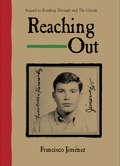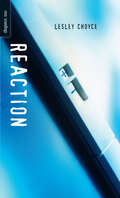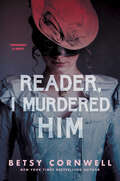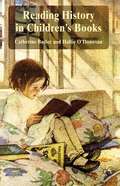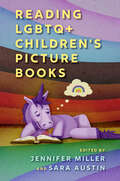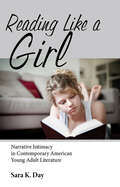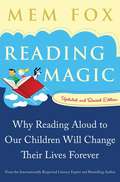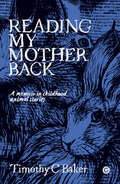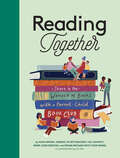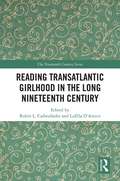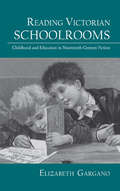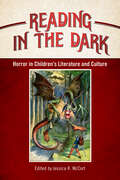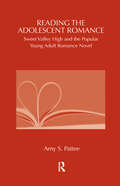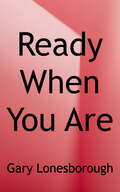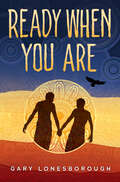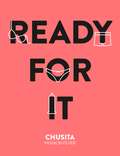- Table View
- List View
Reaching Out (The Circuit #3)
by Francisco Jiménez&“This sequel to Breaking Through and The Circuit again brings to the forefront the daily trials of poor immigrant families . . . compelling and honest.&”—School Library Journal From the perspective of the young adult he was then, Francisco Jiménez describes the challenges he faced in his efforts to continue his education. During his college years, the very family solidarity that allowed Francisco to survive as a child is tested. Not only must he leave his family behind when he goes to Santa Clara University, but while Francisco is there, his father abandons the family and returns to Mexico. This is the story of how Francisco coped with poverty, with his guilt over leaving his family financially strapped, with his self-doubt about succeeding academically, and with separation. Once again his telling is honest, true, and inspiring A Smithsonian Magazine Best Book of the Year &“Rooted in the past, Jiménez&’s story is also about the continuing struggle to make it in America, not only for immigrant kids but also for those in poor families. Never melodramatic or self-important, the spare episodes will draw readers with the quiet daily detail of work, anger, sorrow, and hope.&”—Booklist (starred review) &“In this eloquent, transfixing account, Jiménez again achieves a masterful addition to the literature of the memoir.&”—Smithsonian Magazine &“No one who reads these life stories will forget them. Jiménez reaches out to let us walk in his shoes, feel his pain and pride, joy and sorrow, regrets and hope.&”—Sacramento Bee
Reaction: (reaction) (Orca Soundings)
by Lesley ChoyceZach and Ashley have been going out for a while, and things are going well--until Ashley finds out she is pregnant. She is angry and blames Zach. She wouldn't be in this state if he hadn't been so careless. Insistent at first on an abortion, she turns against Zach. Confused, Zach struggles with what he should do and what his responsibilities are. Coming to terms with the reactions of their families and friends, Zach realizes that this is a decision that he and Ashley must make together. Also available in Spanish.
Reader, I Murdered Him
by Betsy CornwellIn this daring tale of female agency and revenge from a New York Times bestselling author, a girl becomes a teenage vigilante who roams Victorian England using her privilege and power to punish her friends&’ abusive suitors and keep other young women safe. Adele grew up in the shadows—first watching from backstage at her mother&’s Parisian dance halls, then wandering around the gloomy, haunted rooms of her father&’s manor. When she&’s finally sent away to boarding school in London, she&’s happy to enter the brightly lit world of society girls and their wealthy suitors. Yet there are shadows there, too. Many of the men that try to charm Adele&’s new friends do so with dark intentions. After a violent assault, she turns to a roguish young con woman for help. Together, they become vigilantes meting out justice. But can Adele save herself from the same fate as those she protects? With a queer romance at its heart, this lush historical thriller offers readers an irresistible mix of vengeance and empowerment.
Reading About - Big and Small
by Alvin GranowskyThe Reading About series introduces early readers to non-fiction. Each book is designed to increase reading fluency and combines a narrative text, accessible language and an easy-to-follow format.
Reading About - Can I Help?
by Jim PipeThe Reading About series introduces early readers to non-fiction. Each book is designed to increase reading fluency and combines a narrative text, accessible language and an easy-to-follow format.
Reading About - Going to School
by Tammy J. SchleppThe Reading About series introduces early readers to non-fiction. Each book is designed to increase reading fluency and combines a narrative text, accessible language and an easy-to-follow format.
Reading About - Hot and Cold
by Alvin GranowskyThe Reading About series introduces early readers to non-fiction. Each book is designed to increase reading fluency and combines a narrative text, accessible language and an easy-to-follow format.
Reading About - My Family
by Jim PipeThe Reading About series introduces early readers to non-fiction. Each book is designed to increase reading fluency and combines a narrative text, accessible language and an easy-to-follow format.
Reading About - My Pet
by Alvin GranowskyThe Reading About series introduces early readers to non-fiction. Each book is designed to increase reading fluency and combines a narrative text, accessible language and an easy-to-follow format.
Reading About - Sounds
by Alvin GranowskyThe Reading About series introduces early readers to non-fiction. Each book is designed to increase reading fluency and combines a narrative text, accessible language and an easy-to-follow format.
Reading History in Children�s Books
by Catherine Butler Hallie O�donovanThis book offers a critical account of historical books about Britain written for children, including realist novels, non-fiction, fantasy and alternative histories. It also investigates the literary, ideological and philosophical challenges involved in writing about the past, especially for an audience whose knowledge of history is often limited.
Reading LGBTQ+ Children's Picture Books (Children's Literature Association Series)
by Jennifer Miller and Sara AustinContributions by Sara Austin, Rob Bittner, J. Bradley Blankenship, Gabriel Duckels, Caitlin Howlett, Isabel Millán, Jennifer Miller, Kaylee Jangula Mootz, Tim Morris, Dana Rudolph, j wallace skelton, Jason Vanfosson, River Vooris, and B. J. WoodsteinPicture books are books aimed at children where the illustrations are as important, or more important, than the text. Picture books, the effects of their simple text and importance in the literary canon, have been studied by scholars for decades, but little attention has been given to LGBTQ+ picture books. Reading LGBTQ+ Children’s Picture Books is a collection of essays that identifies and interprets children’s picture books that explicitly represent LGBTQ+ content.Contributors to the volume include established and emerging scholars with expertise in the fields of children’s literature, young adult literature, cultural studies, critical race and ethnic studies, gender and sexuality studies, history, and education. Each essay introduces readers to several children’s books that denote unmistakable LGBTQ+ content. Essays bring various interpretive frameworks and intellectual commitments to their unique readings of LGBTQ+ children’s picture books. The essays in Reading LGBTQ+ Children’s Picture Books produce innovative new scholarship about a range of topics including representations of LGBTQ+ marriage and parenting and LGBTQ+ history and culture. The topics explored, and theoretical frameworks applied, significantly expand available and accessible up-to-date scholarship on the growing field of LGBTQ+ children’s picture books.
Reading Like a Girl: Narrative Intimacy in Contemporary American Young Adult Literature (Children's Literature Association Series)
by Sara K. DayBy examining the novels of critically and commercially successful authors such as Sarah Dessen (Someone Like You), Stephenie Meyer (the Twilight series), and Laurie Halse Anderson (Speak), Reading Like a Girl: Narrative Intimacy in Contemporary American Young Adult Literature explores the use of narrative intimacy as a means of reflecting and reinforcing larger, often contradictory, cultural expectations regarding adolescent women, interpersonal relationships, and intimacy. Reading Like a Girl explains the construction of narrator-reader relationships in recent American novels written about adolescent women and marketed to adolescent women. Sara K. Day explains, though, that such levels of imagined friendship lead to contradictory cultural expectations for the young women so deeply obsessed with reading these novels. Day coins the term “narrative intimacy” to refer to the implicit relationship between narrator and reader that depends on an imaginary disclosure and trust between the story's narrator and the reader. Through critical examination, the inherent contradictions between this enclosed, imagined relationship and the real expectations for adolescent women's relations prove to be problematic. In many novels for young women, adolescent female narrators construct conceptions of the adolescent woman reader, constructions that allow the narrator to understand the reader as a confidant, a safe and appropriate location for disclosure. At the same time, such novels offer frequent warnings against the sort of unfettered confession the narrators perform. Friendships are marked as potential sites of betrayal and rejection. Romantic relationships are presented as inherently threatening to physical and emotional health. And so, the narrator turns to the reader for an ally who cannot judge. The reader, in turn, may come to depend upon narrative intimacy in order to vicariously explore her own understanding of human expression and bonds.
Reading Madeleine L’Engle: Ecopsychology in Children’s and Adolescent Literature (Routledge Studies in World Literatures and the Environment)
by Heidi A. LawrenceUsing a critical lens derived from ecopsychology and its praxis, ecotherapy, this book explores the relationships Madeleine L’Engle develops for her characters in a selection of the novels from her three Time, Austin family, and O’Keefe family series as those relationships develop along a human-nonhuman kinship continuum. This is accomplished through an examination both of pairs of novels from the fantastic and the realistic series, and of single novels which stand out as slightly different from the most prominent genre in a given series. Thus, this examination also shows L’Engle’s fluid movement along a fantasy-reality continuum and demonstrates the integration of the three series with each other. Importantly, through examining these relationships and this movement along continuums in these novels, the project demonstrates how ecopsychology and ecotherapy provide strong and important – and as-yet virtually unexplored – intersections with children’s literature.
Reading Magic: Why Reading Aloud to Our Children Will Change Their Lives Forever
by Mem FoxWith passion and humor, Fox speaks of when, where, and why to read aloud and demonstrates how to read aloud to best effect and get the most out of a read-aloud session. She discusses the three secrets of reading, offers guidance on defining and choosing good books.
Reading My Mother Back: A Memoir in Childhood Animal Stories
by Timothy C. BakerAn innovative memoir connecting ideas of grief, memory, and animals to illustrate the importance of storytelling.When his mother died, Timothy C. Baker discovered that there was almost no record of her existence, and no stories that were his to tell: the only way to bring her back was through reading. Reading My Mother Back is a genre-bending memoir that explores a life marked by trauma, illness, religion, and abuse through a focus on the books Baker and his mother shared. The book combines accounts of rereading childhood classics with true and apocryphal stories of a quiet life, marked by great sorrow and great joy. The book is about grief and memory and how our childhood reading shapes the way we see the world; it&’s about loneliness and the search for belonging; it&’s about how ordinary lives are transfigured by storytelling. Moving from accounts of American evangelical communities to kidney failure, from literary criticism to psychoanalysis, and from guilt to love, Baker shows how literature provides a framework for understanding our experiences, and offers a way of connecting with everything we have lost. The book illustrates how children&’s animal stories bring us into a love of the world, and how acts of rereading become a way not of assuaging grief, but of bringing the past and present together. Reading My Mother Back offers a bold and personal view of why the stories we read and share matter so much. And there are bunnies.
Reading Together: Share in the Wonder of Books with a Parent-Child Book Club
by Noah Brown Dominic de Bettencourt Lucy Doherty Owen Lowe-Rogstad Ronan McCannReading Together is the essential guide for parents interested in starting a book club with their kids and raising their children to become book-loving adults.This book is the first guide to parent-child book clubs. Written by a group of moms and their adolescent children who started a book club while the kids were in first grade, this how-to book shares the dos and don'ts they learned over more than 100 meetings and 100 books.Brimming with insight and inspiration, Reading Together includes the details of organizing and structuring meetings, tips on finding diverse books and choosing titles that spur discussion, common book club challenges and how to overcome them, and more.Readers will also find plenty of curated booklists with brilliant recommendations for middle grade and YA readers across genres, from sci-fi to mystery, adventure, and graphic novels. This book is a go-to gift for bookish parents who hope to raise a reader and connect with their community through the magic of books.ONE-OF-A-KIND: With detailed advice gathered over more than a decade and an engaging story at its core, Reading Together is an inspiring and useful handbook for parents looking to start a book club of their own and nurture a love of reading in their kids.A WINNING FORMULA: This book promises a stronger parent-child bond and is a pure celebration of books and reading—a winning recipe.GIFT APPEAL: Reading Together is an attractive gift or impulse-buy for a bookish parent or a parent of bookish kids.Perfect for:• Bookish parents with children• Parents of bookish children• Parents looking to encourage reluctant readers• Parents looking for after-school activities that are good for their kids• Grandparents of school-age children• Elementary school teachers and librarians
Reading Transatlantic Girlhood in the Long Nineteenth Century (The Nineteenth Century Series)
by Robin L. Cadwallader LuElla D’AmicoThis collection is the first of its kind to interrogate both literal and metaphorical transatlantic exchanges of culture and ideas in nineteenth-century girls’ fiction. As such, it initiates conversations about how the motif of travel in literature taught nineteenth-century girl audiences to reexamine their own cultural biases by offering a fresh perspective on literature that is often studied primarily within a national context. Women and children in nineteenth-century America are often described as being tied to the home and the domestic sphere, but this collection challenges this categorization and shows that girls in particular were often expected to go abroad and to learn new cultural frames in order to enter the realm of adulthood; those who could not afford to go abroad literally could do so through the stories that traveled to them from other lands or the stories they read of others’ travels. Via transatlantic exchange, then, authors, readers, and the characters in the texts covered in this collection confront the idea of what constitutes the self. Books examined in this volume include Adelaide Trafton’s An American Girl Abroad (1872), Johanna Spyri’s Heidi (1881), and Elizabeth W. Champney’s eleven-book Vassar Girl Series (1883-92), among others.
Reading Victorian Schoolrooms: Childhood and Education in Nineteenth-Century Fiction (Children's Literature and Culture #44)
by Elizabeth GarganoReading Victorian Schoolrooms examines the numerous schoolroom scenes in nineteenth-century novels during the fraught era of the Victorian education debates. As Gargano argues, the fiction of mainstream and children’s writers such as Dickens, Brontë, and Carroll reflected widespread Victorian anxieties about the rapid institutionalization of education and the shrinking realm of domestic instruction. As schools increasingly mapped out a schema of time schedules, standardized grades or forms, separate disciplines, and hierarchical architectural spaces, childhood development also came to be seen as regularized and standardized according to clear developmental categories. Yet, Dickens, Brontë, and others did not simply critique or satirize the standardization of school experience. Instead, most portrayed the schoolroom as an unstable site, incorporating both institutional and domestic space. Drawing on the bildungsroman’s traditional celebration of an individualized, experiential education, numerous novels of school life strove to present the novel itself as a form of domestic education, in contrast to the rigors of institutional instruction. By positioning the novel as a form of domestic education currently under attack, these novelists sought to affirm its value as a form of protest within an increasingly institutionalized society. The figure of the child as an emblem of beleaguered innocence thus became central to the Victorian fictive project.
Reading Wonderworks: Interactive Worktext Grade 4 (Reading Intervention Ser.)
by Douglas Fisher Timothy Shanahan Jan HasbrouckReseña del editor: The Interactive Worktext for grades 2-6 is a scaffolded version of the Reading Wonders Reading/Writing Workshop. It allows students to interact with complex texts through close reading by taking notes, marking text evidence, and writing responses in their own print or eBook version.
Reading in the Dark: Horror in Children's Literature and Culture (Children's Literature Association Series)
by Jessica R. McCortContributions by Rebecca A. Brown, Justine Gieni, Holly Harper, Emily L. Hiltz, A. Robin Hoffman, Kirsten Kowalewski, Peter C. Kunze, Jorie Lagerwey, Nick Levey, Jessica R. McCort, and Janani SubramanianDark novels, shows, and films targeted toward children and young adults are proliferating wildly. It is even more crucial now to understand the methods by which such texts have traditionally operated and how those methods have been challenged, abandoned, and appropriated. Reading in the Dark fills a gap in criticism devoted to children's popular culture by concentrating on horror, an often-neglected genre. These scholars explore the intersection between horror, popular culture, and children's cultural productions, including picture books, fairy tales, young adult literature, television, and monster movies.Reading in the Dark looks at horror texts for children with deserved respect, weighing the multitude of benefits they can provide for young readers and viewers. Refusing to write off the horror genre as campy, trite, or deforming, these essays instead recognize many of the texts and films categorized as "scary" as among those most widely consumed by children and young adults. In addition, scholars consider how adult horror has been domesticated by children's literature and culture, with authors and screenwriters turning that which was once horrifying into safe, funny, and delightful books and films. Scholars likewise examine the impetus behind such re-envisioning of the adult horror novel or film as something appropriate for the young. The collection investigates both the constructive and the troublesome aspects of scary books, movies, and television shows targeted toward children and young adults. It considers the complex mechanisms by which these texts communicate overt messages and hidden agendas, and it treats as well the readers' experiences of such mechanisms.
Reading the Adolescent Romance: Sweet Valley High and the Popular Young Adult Romance Novel (Children's Literature and Culture)
by Amy PatteeReading the Adolescent Romance provides an exhaustive study of the developments in young adult literature since the 1980s with a focus on Francine Pascal’s "Sweet Valley High" series, which has become a cultural and literary touchstone for both fans and critics of the novels. Pattee carefully examines the series’ content, structure, and readers, allowing her to investigate an influential marketing and literary phenomenon and to interrogate the intersecting influences of history, audience positioning, and readability that allowed "Sweet Valley" and other teen series to flourish. This book demonstrates that, as a series of generic romance novels, "Sweet Valley High" exhibits tropes associated with both adolescent and adult romance and, as a product of the early 1980s, has and continues to espouse the conservative romantic ideologies associated with the time period. While erstwhile readers of the series recall the novels with pleasure, re-readers of Pascal’s novels — who remember reading the series as young people and have re-visted the books as adults — are more critical. Interestingly, both populations continue to value "Sweet Valley High" as an identity touchstone. Amy Pattee is an associate professor of library and information science at the Graduate School of Library and Information Science at Simmons College in Boston, Massachusetts. There, she teaches children’s and young adult literature in both the library school and in a dual degree program affiliated with Simmons College’s Center for the Study of Children’s Literature.
Ready When You Are
by Gary LonesboroughA remarkable YA love story between two Aboriginal boys -- one who doesn't want to accept he's gay, and the boy who comes to live in his house who makes him realize who he is.It's a hot summer, and life's going all right for Jackson and his family on the Mish. It's almost Christmas, school's out, and he's hanging with his mates, teasing the visiting tourists, avoiding the racist boys in town. Just like every year, Jackson's Aunty and annoying little cousins visit from the city -- but this time a mysterious boy with a troubled past comes with them. As their friendship evolves, Jackson must confront the changing shapes of his relationships with his friends, family and community. And he must face his darkest secret -- a secret he thought he'd locked away for good.
Ready When You Are
by Gary LonesboroughA remarkable YA love story between two Aboriginal boys -- one who doesn't want to accept he's gay, and the boy who comes to live in his house who makes him realize who he is.It's a hot summer, and life's going all right for Jackson and his family on the Mish. It's almost Christmas, school's out, and he's hanging with his mates, teasing the visiting tourists, and avoiding the racist boys in town. Just like every year, Jackson's Aunty and annoying little cousins visit from the city -- but this time a mysterious boy with a troubled past comes with them. As their friendship evolves, Jackson must confront the changing shapes of his relationships with his friends, family, and community. And he must face his darkest secret -- a secret he thought he'd locked away for good.
Ready for It
by Chusita Fashion FeverA modern introduction to all things sex, Ready For It delivers honest, accurate information in a wholly relatable voice.YouTube sensation Chusita Fashion Fever gives no nonsense advice on everything from relationships, sexual identity, your first time and the difference between on-screen sex versus #IRL. And this is about real life; Chusita addresses actual questions and concerns posed by her teenage fans. The bold package features body-positive comic illustrations and “fun facts” health sections, while Chusita’s signature voice is authentic and non-judgmental; straight and LGBTI readers are welcome. Myths are debunked and taboos explored—allowing readers to learn not only about the logistics of sex, but about consent, respect, self care, and the intuition needed to make mature sexual decisions with confidence.An Imprint Book
